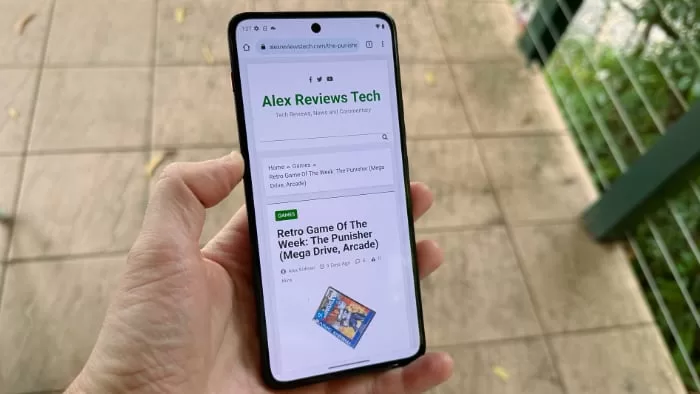Motorola’s adoption of ThinkPad style for its ThinkPhone makes for an interesting take on what a smartphone can be, though it won’t be everyone’s best option.
Pros
Stylish ThinkPad design works well on a phone
Decent battery life
Good overall performance
Included 68W charger
Cons
Cameras are ordinary for a premium-priced phone
Ready For doesn’t work for Macs
Ready For already exists for other Motorola handsets
These days, laptop sub-brands – the names that laptop makers give their notebooks – don’t tend to mean that much to too many people.
The ThinkPad, however, is a bit of a classic. I can’t help but think of it as an IBM brand, because back when I was first breaking into tech journalism (which was, scarily, in a different century), it was IBM’s laptop brand, and IBM was business-first and foremost.
ThinkPad hasn’t been an IBM brand for nearly 20 years now, so clearly I need to update my Filofax… and throw it out for good measure.
The ThinkPad brand is owned by Lenovo, as is the Motorola brand for mobile devices. Lenovo has owned both for some time now, so in some ways it’s a little surprising that it’s taken this long for it to mix the two together into the form of the ThinkPhone.

In many ways, the ThinkPhone is the logical mesh of Motorola’s mobile experience with the ThinkPad’s strong business focus, and that’s good. However, it is also a Motorola phone, and there are some consequences to that as well. Let’s dive into them.
Motorola ThinkPhone: Design

The ThinkPhone from the front looks, honestly, much like any other Android phone in the low premium end of the market that you might choose to buy. It’s built around a 6.6 inch 2400×1080 pixel pOLED display with support for up to 144Hz refresh rates.
One nice feature here that you don’t see on every phone with a faster refresh rate than your standard 60Hz is a full selection of rate choice.
Many opt simply for a dual choice of fixed 60Hz or an “auto” setting that picks what it thinks of as optimal in a given situation. The ThinkPhone does have an Auto setting, but you can alternatively set it to 60Hz, 120Hz or 144Hz depending on your desires.

At the sides you hit the first taste of that ThinkPad style, with a bright red accented button on the left hand side. Motorola calls this the “Red Key”, and it’s a quick launcher for apps, music or screen recording with a single press, or for starting up Motorola’s Ready For suite of Windows connectivity apps. More on that shortly.
On the right hand side the ThinkPhone is a touch more ordinary, with simple volume and power buttons. Biometric unlocking is handled by an in-display fingerprint sensor that’s worked flawlessly during my review period.
Flip the ThinkPhone over and its ThinkPad DNA becomes more apparent, with the same carbon fibre style rear design, accented with “ThinkPhone By Motorola” embossed diagonally at the bottom. It’s certainly a different look for a smartphone, and one that does speak to its business ambitions.
At 189g it’s got a certain quantity of heft to it, but unlike some glass-backed phones I never felt in particular danger of letting it slip from my grasp.
Motorola ThinkPhone: Camera

Motorola’s phones have for the last little while had solid but unspectacular cameras on board; rarely best in their class in other words.
The Motorola ThinkPhone does little to change that picture. At the rear it’s equipped with dual sensors, covering a primary 50MP f/1.8 wide lens and 13MP f/2.2 ultrawide 120° lens that does double duty as a macro lens. Around the front you’ll be taking selfies with a 32MP f/2.45 sensor housed in a centrally mounted holepunch lens.

At the ThinkPhone’s $999 asking price, that’s reasonable for the money, but in no real way exceptional. Now, for a business phone maybe that’s OK, but the reality for most of us is that we don’t carry around multiple phones for different purposes. At this price it’s not hard to get more capable camera systems than Motorola is offering here.
I also hit some issues with Motorola’s camera app being fussy about being launched. This was true both from its direct app button and when double pressing the power button to launch it, with some noticeable delays in getting the actual camera to engage.
That feels more like it’s a software-not-responding problem and not some hardware bottleneck, but the end result was waiting to take a shot far longer than I’d like on a $999 handset.
Actual camera quality was certainly decent, but again nothing that really excited me. There’s no dedicated zoom lens of course, so you’re stuck with digital zoom that maxes out at 8x… and predictably isn’t really worth it:

On the selfie front, the ThinkPhone does an OK job of creating fake bokeh, but again I’ve certainly hit better in this price range:

Video capture is at up to 8K, and again serves its purpose without being particularly great against comparable models. Again, this does feel like it fits the ThinkPhone’s “tool for a purpose” style, but it won’t thrill you if you do have either a personal or work need for particularly sharp photography.
Motorola ThinkPhone Sample Photos





Motorola ThinkPhone: Performance

The ThinkPhone is built around the Qualcomm Snapdragon 8+ Gen 1, which might feel like a curious choice for a phone being released in 2023. After all, Qualcomm’s best of breed right now is the Snapdragon 8 Gen 2. The reason why the ThinkPhone is Gen 1 based isn’t hard to see, however, with the handset developed in 2022, when the Gen 1 was cutting edge, and its debut having already been seen in other markets already.
Still, for most purposes the Snapdragon 8+ Gen 1 is more than enough power, especially given the phone’s business focus. You’re not getting the best-of-the-best, but then again nobody’s selling a Gen 2 phone locally at this price point anyway.
The Snapdragon 8+ Gen 1 benchmarks well in my experience, and I was curious to see how the ThinkPhone compared against other phones you could buy at this kind of price point. With Geekbench 6 scores of 1806 (Single Core) and 4729 (Multi Core) and 3DMark Wild Life Extreme scores of 2814, the answer is that it’s not the best, but it’s certainly competitive in those fields.

Alongside that Gen 1 processor, Motorola sells the version of the ThinkPhone sold locally with 8GB of RAM and 256GB of storage. That’s not the top tier model (12GB RAM/512GB storage), but then it’s undoubtedly been picked to sit below that $1,000 price point this way. It’s an Android 13 phone that, like much of Motorola’s output only takes a light touch to stock Android.
That’s an approach I like; you do still get classics like the Moto gestures that let you fire up the torch with a double shake of the phone – still fun after all these years – as well as Motorola’s “Ready For” software application suite.
Motorola makes a lot of noise about this being a key part of the ThinkPhone’s business case, because it allows for some quite complex integrations between the device and a Windows desktop or laptop.
This does involve installing the Ready For client on a given computer, which could be a more complex matter for some businesses depending on install permissions, but once that hurdle is up and running it’s a nicely realised way to share files, clipboards and use the phone as an ad-hoc hotspot with ease.
My only real caveat here is that it’s not as though Ready For is some new ThinkPhone-only application. Motorola’s offered it on a range of its mid-tier and premium phones for a while now in the exact same way. If it’s Just Ready For you’re after, you don’t have to pay ThinkPhone money for it.
Motorola ThinkPhone: Battery Life

The Snapdragon 8+ Gen 1 generally only wants to sip gently at batteries, but Motorola did set me a challenge with the ThinkPhone, thanks to that 144Hz display. Faster refresh rates by their nature are going to use up more power over time, even with an included 5,000mAh battery.
Battery testing is always a variable matter depending on what you’re doing with a phone. In simple testing with a one hour YouTube video loop and the ThinkPhone set at maximum brightness, it dropped just 3% of its battery capacity.
That bodes well for general all-day battery life, but as always you can push it to less if your needs are more extensive. Testing with the ThinkPhone as an ad-hoc hotspot saw the battery life dip down much more rapidly.
Recharging is either via USB-C at up to 68W, with the ThinkPhone retaining an in-box charger, something that’s becoming a rarity in flagship smartphones these days. At 68W, the supplied charger could also be handy for charging other gadgets too.
Wireless charging is also supported, although at a much more sedate 15W. As always with most wireless charging, you need plenty of patience if that’s how you plan to top up the ThinkPhone.
Motorola ThinkPhone: Verdict

Is the Motorola ThinkPhone a phone for everyone?
No, it’s not. The business focus and especially the business style marks this out as something of a niche phone.
There’s nothing wrong with filling a niche if you do it well, and in the most important aspects that’s precisely what the Motorola ThinkPhone does.
There’s an obvious appeal here if you’re also a ThinkPad user, too, in much the same way that Apple draws folks in to buy Macs if they’re already iPhone users.
Motorola ThinkPhone: Pricing and availability
Officially in Australia, the Motorola ThinkPhone sells through Motorola’s own website and at JB Hi-Fi for $999 outright. There’s no specific carrier contract availability however, so it’d be an outright purchase for your business.
It’s also available through the likes of Amazon, though that’s an international version at a frankly ridiculous markup price.




